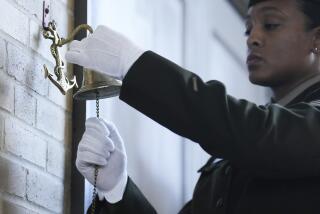Black Civil War troops to get recognition in South Carolina
- Share via
Robert Bohrn cannot forget the black Union soldier whose bones he and another Civil War relic hunter uncovered on Folly Island, S.C., more than 20 years ago.
“It’s one thing to find a coin, a slave tag, a person’s ring,” Bohrn said. “It’s way different to turn your shovel blade over and see a human being.”
Feeling as though he is a caretaker for that soldier and the 18 others whose skeletons were found at the lonely outpost, Bohrn, 53, now is working with South Carolina to erect a historical marker near the site.
He has been fascinated with Civil War history since he was just 5 years old. At 14, he got his first metal detector and combed in and around Charleston, S.C. -- uncovering slave tags, Confederate coins and Union buttons.
Relic hunting became Bohrn’s hobby, if not his passion.
He knew Union soldiers had camped on Folly Island, about 12 miles south of Charleston, during the war, so he hunted for relics there over the years. But the woods were dense with undergrowth and difficult to penetrate.
After a bulldozer cut a rough road in 1987 for a new subdivision, Bohrn and fellow Civil War buff Erik Croen went looking.
They didn’t find what they usually found -- items that a soldier might drop, such as bullets, coins, pieces of knapsacks. The only relics they uncovered were badly deteriorated buttons.
But then Croen dug up what looked like a root. On closer inspection, he realized it was a human femur.
State archaeologists retrieved the bones of 19 black men, ages 16 to 40. All but one lay on their backs, hands across their abdomens. Only two skulls remained. Someone apparently had pilfered the others years before.
About 180,000 black soldiers fought for the Union Army. The best-known regiment was the 54th Massachusetts, immortalized in the movie “Glory.” The men buried on Folly Island are thought to have been part of the 55th Regiment, which fought alongside the 54th in the November 1864 Battle of Honey Hill.
It wasn’t Confederate bullets that killed them. It was disease -- dysentery, malaria, typhoid.
“They gave their lives for their country in a horrendous way,” Bohrn said. “They didn’t die instantly. They just withered away.”
Their remains were reburied on Memorial Day 1989 at Beaufort National Cemetery in South Carolina. But Bohrn believes that the site of their first burial also should be acknowledged.
“When you see that guy laying there, who never had a chance to go home, who never saw his family, that saddens me,” Bohrn said. “It has always been my dream to have an historical marker put on Folly.”
Historical markers must be privately funded in South Carolina. Bohrn said that with the help of a website for relic hunters, he has raised $1,830 to cover the costs.
If all goes as planned, a marker will be erected at the island’s community center on May 8, the 23rd anniversary of the discovery.
Tracy Power, coordinator of the South Carolina Historical Marker Program, plans to help Bohrn with the wording.
“So few people know about the U.S. Colored Troops,” Power said. “Anything we can do to help tell that story is a good thing.”
More to Read
Sign up for The Wild
We’ll help you find the best places to hike, bike and run, as well as the perfect silent spots for meditation and yoga.
You may occasionally receive promotional content from the Los Angeles Times.






